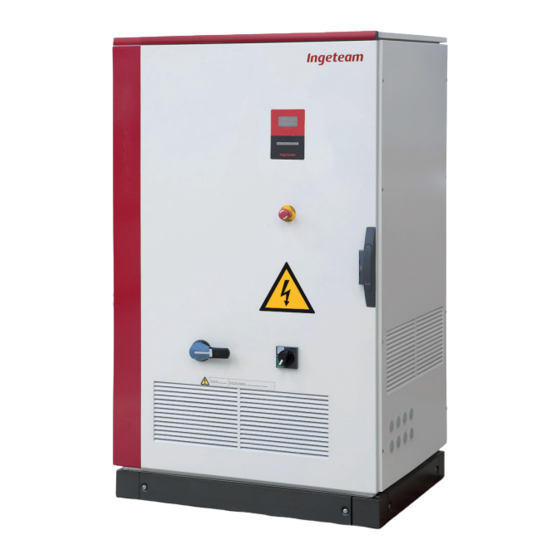
Table of Contents
Advertisement
Advertisement
Table of Contents

Summarization of Contents
Important Safety Precautions
General Warnings
Key safety warnings regarding qualified personnel, electrical hazards, and proper handling of the inverter.
Potential Hazards for Equipment
Personal Protection Equipment (PPE)
Lists the standard personal protective equipment required for safe operation and maintenance.
1. Overview
1.1. Equipment Description and Models
Describes the inverter's function and lists available models in the product family.
2. System Description
2.1. Location and Environmental Requirements
Guidelines for selecting installation location and suitable environmental conditions including temperature, humidity, and IP rating.
2.2. Electrical Installation Characteristics
Describes connection requirements for low voltage public grids and IT neutral schemes.
2.3. EMC Requirements
Explains EMC requirements and filtering for industrial applications.
3. Operating, Conservation, and Transport Conditions
3.1. Symbols and Handling
Explains handling symbols and procedures for receiving and unpacking the equipment.
3.2. Equipment Reception and Packaging
Details procedures for receiving shipments, checking contents, and recycling packaging materials.
3.3. Handling and Unpacking
Provides guidelines for correctly handling and unpacking the unit to prevent damage.
3.4. Moving the Equipment
Outlines recommended methods and precautions for moving the inverter.
3.5. Storage Procedures
Specifies points to consider for storing the unit to prevent damage, including position and environmental conditions.
3.6. Conservation and Waste Handling
Covers unit conservation, packaging damage, and proper waste handling and recycling procedures.
4. Safety Instructions
4.1. Safety Symbols and General Precautions
Explains hazard symbols, general precautions, and risk management for safe operation.
4.3. Handling Tasks and Safety Measures
Covers additional risks in handling, types of tasks, PPE, and safety measures while working.
5. Installation
5.1. General Installation Requirements and Fixing
Covers general installation needs, fixing the unit to the floor, and dimensions.
5.3. Transformers and Insulation Monitor for TL Models
Technical characteristics of grid connection and auxiliary transformers for TL models.
5.4. Electrical Connection Procedures
Guides on making electrical connections, including safety, cable inlets, and connections.
5.4.3. Connection Sequence, Diagrams, and Indicators
Specifies connection order, system wiring diagrams, and insulation fault/grid connection indicators.
5.4.6. Auxiliary and RS-485 Communication Connections
Details access to auxiliary connections and communication setup via RS-485 serial port.
5.4.8. GSM/GPRS Communication Connection
Explains the optional hardware connection for communication via GSM/GPRS modem.
5.4.9. Ethernet Communication Connection
Details the hardware and connection procedure for communication via ethernet.
5.4.10. Ground, Auxiliary Supply, and Grid Connections
Covers ground connections, auxiliary supply requirements, and grid connection procedures.
5.4.13. Connecting to the PV Array
Guides on connecting the unit to the PV array, including safety and cable specifications.
5.5. Unit Synchronization
Explains the necessity and procedure for synchronizing multiple TL units connected to the same transformer.
5.6. Available Kits
5.6.1. Nighttime Power Supply and Grounding Kits
Describes the nighttime power supply and grounding kits for the inverter.
5.6.3. Remote Triggering and Heating Resistor Kits
Details the remote triggering and heating resistor kits for specific applications.
6. Commissioning
6.1. Equipment Inspection
Details essential checks and inspections required before unit start-up.
6.2. Start-up and Verification Procedures
Covers inverter start-up, checks, measurements, and verification of parameters.
7. Preventive Maintenance
7.1. Maintenance Tasks and Checks
Details specific tasks like checking enclosure, cables, terminals, and cleaning vents.
8. Display Control
8.1. Keypad and LED Indicators
Describes the function of the keypad and the meaning of front panel LED indicators.
8.2. Display Information and Functions
Details display information, including date, time, node number, and keypad functions.
8.3. Main Menu and Monitoring Parameters
Outlines the main menu structure and how to interpret monitoring parameters.
8.5. Alarms, Shutdown Reasons, and History
Lists alarms, their codes, reasons for shutdown, and historical data for troubleshooting.
8.6. Settings and Configuration Options
Covers settings for date/time, language, grid limits, connection time, and reset options.
8.7. Inverter Data and Number Assignment
Displays inverter-specific data and allows changing the inverter number.
8.8. Changing Inverter Number
Instructions on how to assign a number to the inverter for communication configuration.
9. Troubleshooting
9.1. LED Messages and Status Indicators
Explains the meaning of LED indicators for normal operation and fault conditions.
9.1.3. Insulation Fault Diagnosis
Provides a step-by-step procedure to diagnose and determine the cause of insulation faults.
9.2. Alarms and Shutdown Reasons List
Lists alarms, their codes, reasons for shutdown, and descriptions for troubleshooting.
9.3. Alarms Due to Protection Triggering
Explains alarms related to AC and DC protection elements being triggered.
9.4. Incident Response Protocol and Frequency/Voltage Alarms
Outlines incident response and troubleshooting for voltage/frequency out-of-range alarms.
9.4.2. Temperature Alarms and Checks
Addresses temperature alarms, radiator checks, ventilation, and NTC/thermal switch diagnostics.
9.4.3. AC/DC Circuit Protection and Contactor Issues
Details checks for AC/DC circuit protections, contactor shutdown, and fuses.
9.4.6. Insulation Fault and Manual Shutdown Procedures
Guides on checking insulation faults and troubleshooting manual shutdown alarms.
9.4.8. Switching Filter Protection and Electronic Block Replacement
Covers checks for switching filter protection and procedures for replacing the electronic block.
9.6. Replacing Intake Board Varistors
Guides on checking and replacing varistors on the intake board.
9.7. Terminal Strip Description and Equipment Layout
Details terminal strip functions and provides an overview of equipment layout.
















Need help?
Do you have a question about the Ingecon Sun 50 and is the answer not in the manual?
Questions and answers